Game review: ゼルダの伝説: the Hyrule Fantasy
Kind of like when I played Super Metroid, playing this makes me wonder if I'm really a "Zelda fan," whatever that means. I've played even fewer Zelda games than Metroid games, but in part, this is an attempt to remedy that. Since Sunday was the 30th anniversay of the original Legend of Zelda coming out, I wanted to go back and play some of the earlier Zelda games I missed as well as the good ones that I loved, so I thought why not start at the beginning? And, since I've never played it, why not start with the Japanese version like I did with 悪魔城伝説 and see what the differences are?
And that answer is...not that much, really. Other than being in Japanese--and that's not even entirely true, since the intro is in English--everything is pretty much the same. Most of the quotes are translated pretty literally, and the minor nuances in meaning don't affect what story there is. For example, "It's dangerous to go alone! Take this," in Japanese is, "ヒトリデハキケンジャ コレヲ サズケヨウ," which is, "It's dangerous by yourself. I'll bestow this [to you]," though with a bit of an old man nuance that doesn't really translate into English and with some implied status differences--授ける is generally used from a higher-ranking person to a lower one, though here I think it's just that it's an old man giving the sword to a whippersnapper.
And yes, the katakana and spaces are in the game. I think it's the first time I've ever seen a ヲ in the wild.
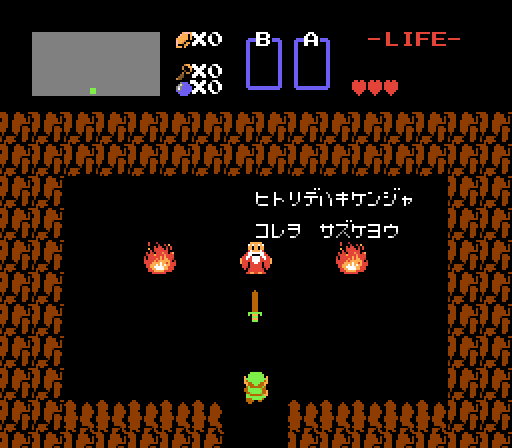
Your powers are weak, old man.
I forgot just how little the game tells you about anything. After the intro explaining the plot, that "Gannon" has kidnapped Zelda but not before she split the Triforce of Wisdom into eight pieces and instructed her servant to find someone worthy to save Hyrule, it dumps you into the main screen. There's a cave in front of you where condescending old man gives you the wooden sword, but it's entirely possible to finish almost the entire game without even getting it. You constantly find people in caves or in secret dungeon rooms who give you cryptic hints like "Dodongos hate smoke" and "Meet the old man at the grave" and "Secret is in the tree at the dead-end" and "Grumble grumble" and have to figure out what they mean.
Then you spend hours wandering around a continuous overworld, eventually realizing that any particular rock could conceal a cave and any particular bush could have a hidden stair. You find your way to the Forest of Maze, head up and up to Dungeon 5, walk into the waterfall, and push the gravestone. What is that old guy doing down there, anyway?
It's kind of like Dark Souls, actually. The world has that same sense of mystery, there are enemies everywhere and weird people who spout cryptic catchphrases, and exactly what you have to do at any moment is unclear. The comparison is pretty shallow--Legend of Zelda is good, but it doesn't have the excellent level design that Dark Souls does, for example--but there's a bit of DNA there.
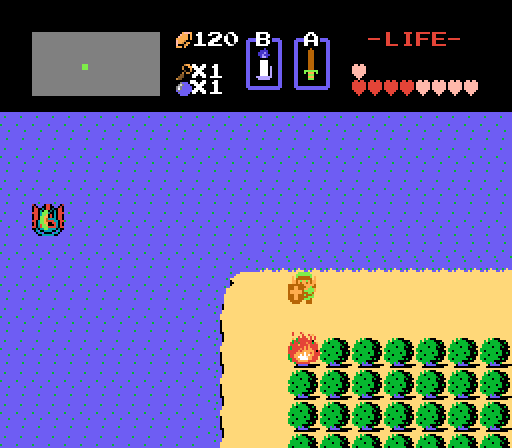
Bomb every rock, burn every bush.
Just as an example of mysteries, I missed the bow in Level 1 and spent most of the game wondering where the hell it was. It wasn't until I got the magic rod and then to Gohma in Level 6, whereon I remembered that Level 7 has the candle upgrade and Level 8 has the magic book, realized that I must have forgotten something since Gohma requires the bow to beat, and went back and checked online to see what happened. No wonder a lot of those bosses were so difficult. I kept having to run up and stab people and I was waiting until I got the wand so that I'd have a reliable ranged weapon that wasn't the boomerang and wondering why things were so difficult. I can't even claim playing the Second Quest as an excuse, since I never got any distance in it.
I was aided in my quest by this interactive Legend of Zelda map, put together by some kind soul on the internets. I used that to pick up all the heart containers and find a few of the rupee secret chambers--and avoid the people who charge you for breaking into their secret hiding places--just to save some time. I've paid my dues back in the day, when I bombed every wall and burned every bush on those afternoons in front of the NES. Right now I have other silly repetitive tasks that I'm planning to do, like click every item on every other item in Gabriel Knight or hump every wall in Doom II.
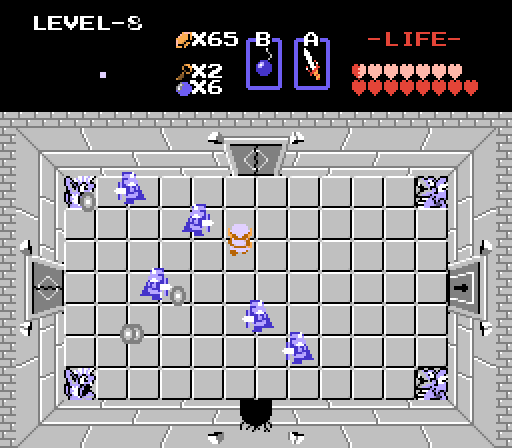
The worst room in the game.
All of that said, playing it was often pretty frustrating. Legend of Zelda only allows you to move and attack in the four cardinal directions other than some diagonal tricks with the boomerang but places no such restrictions on your opponents. Most of them obey the four-directions thing, but a lot of the bosses hurl fireballs all over the place, forcing you to run in squares off in a corner somewhere and hope you can get in a shot. Or a stab, in my case, since I didn't have the bow.
I guess that's actually kind of necessary since most of the bosses are not particularly hard. The ones that aren't puzzle bosses like Dodongo or Digdogger rely on spamming a ton of shots everywhere and moving very quickly but don't have all that much health. I was generally more worried about fighting a room with blue darknuts in it than I was fighting any of the bosses, and it also worked against one of my favorite tropes--a boss becoming a regular enemy. Done well, it can make you feel like you've progressed from a callow youth to a hardened warrior, felling multiple opponents where a single one would once have given you pause. But none of the bosses ever gave me pause other than Gohma, but that's because I screwed up Level 1, not because it's actually difficult. One you get the bow and arrow, you can literally kill him in a single shot.
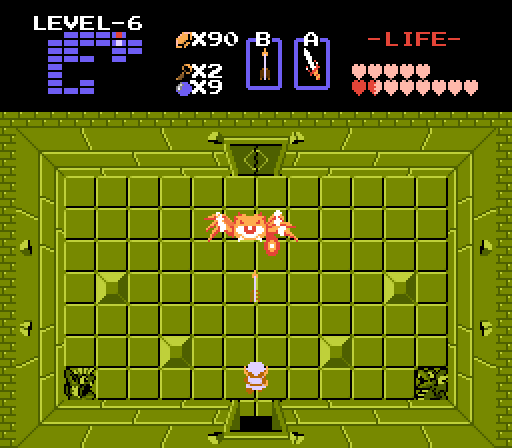
You attack its weak point for massive damage.
In some ways, I think that I cheated myself out of the game. The meat of The Legend of Zelda isn't in fighting the monsters, which is predictable if they're bound to cardinal direction movements and frustrating if they're not. No, the real meat is figuring out where you have to go, what you have to do to beat Dodongo, where the entrance to to the dungeons are, where the magic sword (not yet the Master Sword) is, any number of things. You're left with a few cryptic hints and a world to explore, and it's putting all the pieces together that makes it fun. Or some of the pieces, at least. I never did find the power bracelet...
Not that I hated playing it or think it wasn't worthwhile, mind you. Even through the frustration and using an interactive map, I had a lot of fun. But I think some of that fun came from knowing that I had already beaten it in the intended manner and I was retracing my footsteps. Or segwaying alongside them, at least.
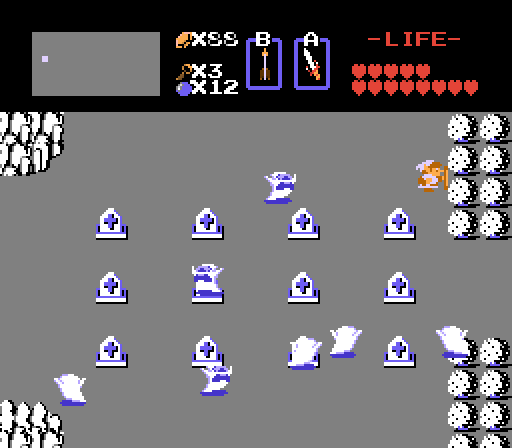
Uh, which one was it again?
It was a good game. It's still a good game, though not my favorite Zelda game. I might have continued on to Second Quest if I didn't have more games to play than remaining time in my life, but alas. I also want to play at least the next few chronological Zelda games, two of which I've never really played at all ( Zelda II and Link's Awakening). Link's Awakening I especially hear is amazing, but since I never had a Game Boy I never had the chance to play it. But this is the modern age, when a cornucopia of gaming lies all around us, ready for the plucking.
Assuming I don't rage-quit the whole project halfway through Zelda II, anyway.
If you're interested in all the differences between The Legend of Zelda and ゼルダの伝説: the Hyrule Fantasy, look at this article.
And that answer is...not that much, really. Other than being in Japanese--and that's not even entirely true, since the intro is in English--everything is pretty much the same. Most of the quotes are translated pretty literally, and the minor nuances in meaning don't affect what story there is. For example, "It's dangerous to go alone! Take this," in Japanese is, "ヒトリデハキケンジャ コレヲ サズケヨウ," which is, "It's dangerous by yourself. I'll bestow this [to you]," though with a bit of an old man nuance that doesn't really translate into English and with some implied status differences--授ける is generally used from a higher-ranking person to a lower one, though here I think it's just that it's an old man giving the sword to a whippersnapper.
And yes, the katakana and spaces are in the game. I think it's the first time I've ever seen a ヲ in the wild.

Your powers are weak, old man.
I forgot just how little the game tells you about anything. After the intro explaining the plot, that "Gannon" has kidnapped Zelda but not before she split the Triforce of Wisdom into eight pieces and instructed her servant to find someone worthy to save Hyrule, it dumps you into the main screen. There's a cave in front of you where condescending old man gives you the wooden sword, but it's entirely possible to finish almost the entire game without even getting it. You constantly find people in caves or in secret dungeon rooms who give you cryptic hints like "Dodongos hate smoke" and "Meet the old man at the grave" and "Secret is in the tree at the dead-end" and "Grumble grumble" and have to figure out what they mean.
Then you spend hours wandering around a continuous overworld, eventually realizing that any particular rock could conceal a cave and any particular bush could have a hidden stair. You find your way to the Forest of Maze, head up and up to Dungeon 5, walk into the waterfall, and push the gravestone. What is that old guy doing down there, anyway?
It's kind of like Dark Souls, actually. The world has that same sense of mystery, there are enemies everywhere and weird people who spout cryptic catchphrases, and exactly what you have to do at any moment is unclear. The comparison is pretty shallow--Legend of Zelda is good, but it doesn't have the excellent level design that Dark Souls does, for example--but there's a bit of DNA there.

Bomb every rock, burn every bush.
Just as an example of mysteries, I missed the bow in Level 1 and spent most of the game wondering where the hell it was. It wasn't until I got the magic rod and then to Gohma in Level 6, whereon I remembered that Level 7 has the candle upgrade and Level 8 has the magic book, realized that I must have forgotten something since Gohma requires the bow to beat, and went back and checked online to see what happened. No wonder a lot of those bosses were so difficult. I kept having to run up and stab people and I was waiting until I got the wand so that I'd have a reliable ranged weapon that wasn't the boomerang and wondering why things were so difficult. I can't even claim playing the Second Quest as an excuse, since I never got any distance in it.
I was aided in my quest by this interactive Legend of Zelda map, put together by some kind soul on the internets. I used that to pick up all the heart containers and find a few of the rupee secret chambers--and avoid the people who charge you for breaking into their secret hiding places--just to save some time. I've paid my dues back in the day, when I bombed every wall and burned every bush on those afternoons in front of the NES. Right now I have other silly repetitive tasks that I'm planning to do, like click every item on every other item in Gabriel Knight or hump every wall in Doom II.

The worst room in the game.
All of that said, playing it was often pretty frustrating. Legend of Zelda only allows you to move and attack in the four cardinal directions other than some diagonal tricks with the boomerang but places no such restrictions on your opponents. Most of them obey the four-directions thing, but a lot of the bosses hurl fireballs all over the place, forcing you to run in squares off in a corner somewhere and hope you can get in a shot. Or a stab, in my case, since I didn't have the bow.
I guess that's actually kind of necessary since most of the bosses are not particularly hard. The ones that aren't puzzle bosses like Dodongo or Digdogger rely on spamming a ton of shots everywhere and moving very quickly but don't have all that much health. I was generally more worried about fighting a room with blue darknuts in it than I was fighting any of the bosses, and it also worked against one of my favorite tropes--a boss becoming a regular enemy. Done well, it can make you feel like you've progressed from a callow youth to a hardened warrior, felling multiple opponents where a single one would once have given you pause. But none of the bosses ever gave me pause other than Gohma, but that's because I screwed up Level 1, not because it's actually difficult. One you get the bow and arrow, you can literally kill him in a single shot.

You attack its weak point for massive damage.
In some ways, I think that I cheated myself out of the game. The meat of The Legend of Zelda isn't in fighting the monsters, which is predictable if they're bound to cardinal direction movements and frustrating if they're not. No, the real meat is figuring out where you have to go, what you have to do to beat Dodongo, where the entrance to to the dungeons are, where the magic sword (not yet the Master Sword) is, any number of things. You're left with a few cryptic hints and a world to explore, and it's putting all the pieces together that makes it fun. Or some of the pieces, at least. I never did find the power bracelet...
Not that I hated playing it or think it wasn't worthwhile, mind you. Even through the frustration and using an interactive map, I had a lot of fun. But I think some of that fun came from knowing that I had already beaten it in the intended manner and I was retracing my footsteps. Or segwaying alongside them, at least.

Uh, which one was it again?
It was a good game. It's still a good game, though not my favorite Zelda game. I might have continued on to Second Quest if I didn't have more games to play than remaining time in my life, but alas. I also want to play at least the next few chronological Zelda games, two of which I've never really played at all ( Zelda II and Link's Awakening). Link's Awakening I especially hear is amazing, but since I never had a Game Boy I never had the chance to play it. But this is the modern age, when a cornucopia of gaming lies all around us, ready for the plucking.
Assuming I don't rage-quit the whole project halfway through Zelda II, anyway.
If you're interested in all the differences between The Legend of Zelda and ゼルダの伝説: the Hyrule Fantasy, look at this article.